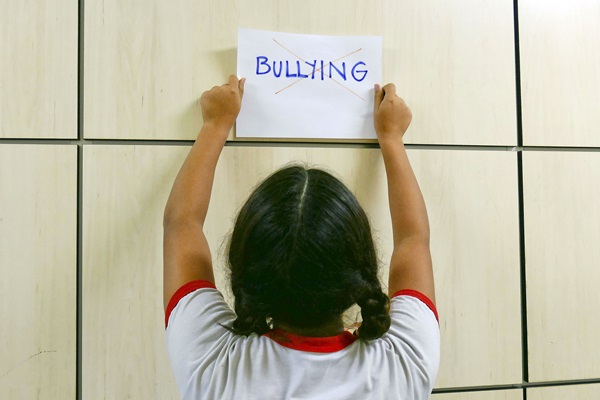Bullies have been a harsh reality of life as long as humans have been around, but social media platforms and smartphones sadly offer new ways to wound people. In today's climate, the hurtful words or actions that used to end after the school day can follow students anywhere they go.
October has been designated Bullying Prevention Month in the U.S. and despite staggering statistics about the severity of this problem, there are things individuals can do about bullying.
Amy McMullen, an assistant youth director at St. Luke's United Methodist Church in Highland Ranch, Colorado, believes the seeming anonymity of the internet can compound the issue.
"Cyberbullying is so popular and easy because it removes the human-ness. When we stop seeing people and merely start seeing words posted on a screen, we lose our sense of empathy, love, and kindness…Despite not seeing or hearing a person through Facebook or Instagram comments…there is, indeed, a human typing those words."
Remembering our human connection and seeking to "do no harm" are key concepts as youth leaders, parents, friends, and families face the tough reality of today's digital landscape.
1. Recognize the scope of the problem
In the U.S., government research shows that:
- 28% of U.S. students in grades 6–12 experience bullying.
- 30% of young people admit to bullying others.
- 70.6% of young people say they have seen bullying in their schools.
And these statistics are pretty similar in other countries. Bullying is a fact of life for many young people so we need to find ways to reduce the risk and counter the consequences where possible.
2. Learn what bullying is and also what it is not.
This differentiation helps determine the best ways to seek resolution. Bullying is typically defined as unwanted, aggressive behavior among school age children that involves a power imbalance and is repetitive. More serious actions like hazing, harassment, and stalking, among older individuals, are not bullying. Cyberbullying includes sending, posting, or sharing negative, harmful, false, or mean content about someone else via digital devices.
3. Pay attention to warning signs
Notice whether a child is acting differently, or is dealing with unusual symptoms like unexplained injuries, lack of appetite, or sleeplessness. When you see signs, take appropriate action, whether by contacting the correct school representative, a mental health counselor, or a crisis hotline such as the U.S. Suicide Prevention Lifeline at 1-800-273-TALK (8255).
4. Emphasize empathy
Bullying has a powerful and lasting impact on all of the people involved, and addressing it well means considering many factors.
McMullen notes: "We understand that some of our youth may be victims of cyberbullying and that we need to support them and help them see that their value and worth go far beyond what someone may post; however it is just as important to understand that some of our youth may actually be the perpetrators of cyberbullying and many, if not all, will be witnesses of it. Emphasizing that there is a real-life person behind the screen is our main goal-- partially for the youth who may be tempted to bully, but mostly for the youth who will witness it and do nothing. We emphasize the importance of saying something, of standing up for those who are being bullied. And lastly, we help them understand that more often than not, those who bully have also been bullied themselves."
5. Keep the conversation going and encourage kids to find activities they enjoy.
Talking with young people about their school day, their friends, and what they like to do are good ways to help them know you care and that you can be trusted to hear their concerns and help as needed.
6. Support anti-bullying groups and learn steps to take.
There are a variety of programs and school efforts working to address the problem proactively. Learn more about these and find ways to volunteer or donate. And keep in mind the best ways to respond on the spot.
7. Remember this is our call as Christians.
The United Methodist Church has a zero tolerance policy for bullying. In 2016, these words were added to the United Methodist Book of Discipline: "Bullying is a growing problem in parts of the connection. It is a contributing factor in suicide and in the violence we see in some cultures today…As the Church, we can play a pivotal role in ending this problem. We urge churches to seek opportunities to be trained in responding to the needs of those who have been bullied, to those who perpetrate bullying, and to support those in authority who may witness or be called to intervene on behalf of those who have been bullied…We encourage churches to adopt a policy of zero tolerance for bullying, including cyberbullying, within their spheres of influence; stand with persons being bullied, and take a leadership role in working with the schools and community to prevent bullying."
Church members can model love and respect within church walls, and continue the conversation when people leave the buildings and turn on their phones.
McMullen says the church should always be a safe space and offer the connections needed to make true friendships offline, too. "Reacting to bullying and hate with more bullying and hate does nothing. It's easy to send a nasty post back when someone says something mean; it's harder to hold them with kindness. Kindness and understanding, however, are the only ways things will change and put an end to the cycle of bullying."
This story was first published on Sept. 28, 2018. Freelance writer Jordan Taylor was a contributing author.





